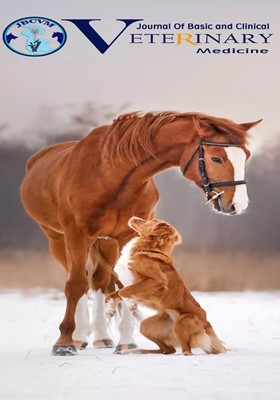Surgical management of atresia coli in a Darehshouri foal
Subject Areas : SurgeryFatemeh Heydari 1 , Amir Hessam Torghabe 2 * , Hamid Reza Siahkouhi 3 , Mohammad Shahraki 4 , Fattah Iranmanesh 5 , Mohammad Mehdi oloumi 6 , Ehsanollah Sakhaee 7 , Alborz Mirzadeh 8
1 - Department of Clinical Sciences, Faculty of Veterinary Medicine, Shahid Bahonar University of Kerman, Kerman, Iran
2 - Department of Clinical Sciences, Faculty of Veterinary Medicine, Shahid Bahonar Unioversity of Kerman, Kerman, Iran
3 - Department of Clinical Sciences, Faculty of Veterinary Medicine, Shahid Bahonar University of Kerman, Kerman, Iran
4 - Department of Clinical Sciences, Faculty of Veterinary Medicine, Shahid Bahonar University of Kerman, Kerman, Iran
5 - Department of Clinical Sciences, Faculty of Veterinary Medicine, Shahid Bahonar University of Kerman, Kerman, Iran
6 - Department of Clinical Sciences, Faculty of Veterinary Medicine, Shahid Bahonar University of Kerman, Kerman, Iran
7 - Clinical Sciences, Veterinary Faculty, Shahid Bahonar University, Kerman, Iran
8 - Department of Clinical Sciences, Faculty of Veterinary Medicine, Shahid Bahonar University of Kerman, Kerman, Iran
Keywords: Anastomosis, Atresia coli, Darehshouri Foal,
Abstract :
Atresia coli is a rare congenital abnormality that result in an inability to pass feces since birth. Signs of colic progressed during 24 hours of first life in this defect. The equine large intestine consists of the following segments: cecum, large colon, and small colon. Colon is the segment of intestine that most often involved (Atresia coli). The popular theory related to the pathogenesis of intestinal atresia is vascular accident. If the foal can’t pass meconium during 12 hours after birth ,it could be described as ‘retained meconium’. Atresia coli can diagnosed by clinical signs, physical examinations and diagnostic imaging. surgical prognosis of atresia coli is poor. In this study a Darehshouri foal was presented with signs of colic and absence of meconium repelling. The final diagnosis of partial agenesis of the right dorsal colon (type III colon atresia) was confirmed during laparotomy. End to end anastomosis between remained right dorsal and transverse colon was done.
[1] Van der Gaag, I. and Tibboel, D. (1980) Intestinal atresia and stenosis in animals: A report of 34 cases. Vet. Path. 17, 565-574.
[2] Elsa, A., Onyeyili P., Surgical management of small intestinal atresia in Sokoto red goats. Pak J Biol Scien, 2004; 7(11): 2024-2025,.
[3] Srivastava, P., Gangopadhyay A., Gupta D., Sharma S., Upadhyaya V.D., Kumar V., Jaiman R. Atresia of ileocecal junction, ileocecal valve: Rare variants of bowel atresia. J Indian Assoc Pediatr Surg, 2009; 14(3): 117.
[4] Bai, Y., Chen, H., Yuan, Z.W., Wang, W.: Normal and abnormal embryonic development of the anorectum in rats. J Pediatr Surg, 2004; 39: 587-590.
[5] Cassini, P., Montironi, A., Botti, S., Hori, T., Okhawa, H., Stella, A., Andersson, L., Giuff ra, E.: Genetic analysis of anal atresia in pigs: evidence for segregation at two main loci. Mamm Genome, 2005; 16: 164-170.
[6] Mair, T.S., Divers T.J., Ducharme N.G. Manual of equine gastroenterology, WB Saunders, 2002.
[7] MICHAEL W. ROSS R. REID HANSON, JR., C-19-Large-Intestine-Equine-Surgery-Equine-Surgery-1992
[8] Nappert, G., Laverty, S., Drolett, R., Naylor, J. Atresia Coli in 7 Foals (1964-1990). Equine Vet J, 1992; Suppl. I3: 57-60.
[9] Hunter, B., Belgrave, R.L., Atresia coli in a foal: Diagnosis made with colonoscopy aided by N-butylscopolammonium bromide. Equine Vet Educ, 2010; 22 (9): 429-433.
[10] Kilic, N., Sarierler, M. Congenital intestinal atresia in calves: 61 cases. Revue Méd Vét, 2004; 155(7):381-384.
[11] Azizi, S., Mohammadi, R., Mohammadpour, I. Surgical repair and management of congenital intestinal atresia in 68 calves. Vet Surg, 2010; 39(1):115-120.
[12] Laikul, A., Phetudomsinsuk, K., Aumarm, W., Sritrakul, T., Prukudom, S., Congenital colonic atresia in horse. J Kasetsart Vet, 2010; 20(1): 36-40.
[13]. Fischer, A.T. (2006) Colic: diagnosis, preoperative management, and surgical approaches. In: Equine Surgery, 3rd edn., Eds: J.A. Auer and A. Stick, W.B. Saunders, St Louis. p 393.

